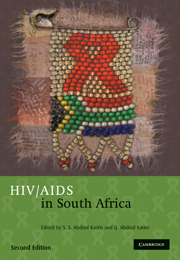Book contents
- Frontmatter
- Contents
- List of Contributors
- Foreword: Peter Piot
- Foreword: Nelson R Mandela
- Acknowledgements
- Section 1 Birth of a rapidly growing epidemic
- Section 2 The virus, the human host and their interactions
- Section 3 HIV risk factors and prevention strategiess
- Section 4 Focal groups for understanding the HIV epidemic
- Section 5 The impact of AIDS
- Section 6 Treating HIV
- 27 Tuberculosis and HIV
- 28 Prevention of opportunistic infections in adults
- 29 Nutritional prophylaxis
- 30 Challenges in managing AIDS in South Africa
- 31 Antiretroviral therapy
- 32 The challenges of implementing antiretroviral treatment in South Africa
- Section 7 What does the future hold?
- Index
31 - Antiretroviral therapy
Published online by Cambridge University Press: 07 September 2011
- Frontmatter
- Contents
- List of Contributors
- Foreword: Peter Piot
- Foreword: Nelson R Mandela
- Acknowledgements
- Section 1 Birth of a rapidly growing epidemic
- Section 2 The virus, the human host and their interactions
- Section 3 HIV risk factors and prevention strategiess
- Section 4 Focal groups for understanding the HIV epidemic
- Section 5 The impact of AIDS
- Section 6 Treating HIV
- 27 Tuberculosis and HIV
- 28 Prevention of opportunistic infections in adults
- 29 Nutritional prophylaxis
- 30 Challenges in managing AIDS in South Africa
- 31 Antiretroviral therapy
- 32 The challenges of implementing antiretroviral treatment in South Africa
- Section 7 What does the future hold?
- Index
Summary
THE MAIN AIM OF antiretroviral therapy is to delay or prevent the progression to AIDS and death of HIV-infected patients. However, even successful therapy does not completely prevent clinical events, particularly when started in advanced disease. Furthermore, antiretroviral therapy is required for life, since it cannot eradicate latent HIV.
Commonly used drug categories include nucleoside reverse transcriptase inhibitors (nrtis), non-nucleoside reverse transcriptase inhibitors (nnrtis) and protease inhibitors (pis). Current guidelines on when to start antiretroviral therapy are based on us and international hiv treatment recommendations that use a combination of evidence from randomised clinical trials, observational cohorts and expert opinion. All the guidelines emphasise initiating antiretroviral therapy for patients with hiv-related symptoms. Poor adherence is the major cause of failure to achieve viral suppression and remains a particular challenge in the developing world, although studies have shown that adherence is possible where patients are supported. Indications for changing antiretrovirals include drug toxicity, drug intolerance and treatment failure. Drug resistance is a problem in the face of a highly mutationprone virus. This is exacerbated by drug pressure and measurement of drug resistance can be helpful in guiding treatment. Scaling up of antiretroviral programmes in the public sector in South Africa will require standardisation and simplification of treatment regimens.
The antiretroviral treatment era started in 1987 with the approval of zidovudine, a thymidine nucleoside analogue that targets the reverse transcriptase enzyme, necessary for the replication of the human immunodeficiency virus (hiv).
- Type
- Chapter
- Information
- HIV/AIDS in South Africa , pp. 529 - 550Publisher: Cambridge University PressPrint publication year: 2010



